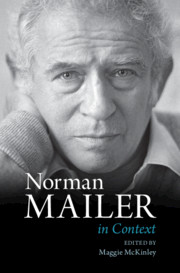Book contents
- Norman Mailer in Context
- Norman Mailer in Context
- Copyright page
- Contents
- Notes on Contributors
- A Note on References and Abbreviations
- Introduction
- Part I Literary Influences
- Chapter 1 Early Influences
- Chapter 2 Mailer and Hemingway
- Chapter 3 Friendships and Feuds
- Part II Form and Genre
- Part III Political Contexts
- Part IV Philosophical and Cultural Contexts
- Part V Gender and Sexuality
- Part VI Profiles and Literary Biographies
- Part VII Mailer’s Legacy
- Primary Bibliography
- Selected Secondary Bibliography
- Index
Chapter 2 - Mailer and Hemingway
from Part I - Literary Influences
Published online by Cambridge University Press: 05 August 2021
- Norman Mailer in Context
- Norman Mailer in Context
- Copyright page
- Contents
- Notes on Contributors
- A Note on References and Abbreviations
- Introduction
- Part I Literary Influences
- Chapter 1 Early Influences
- Chapter 2 Mailer and Hemingway
- Chapter 3 Friendships and Feuds
- Part II Form and Genre
- Part III Political Contexts
- Part IV Philosophical and Cultural Contexts
- Part V Gender and Sexuality
- Part VI Profiles and Literary Biographies
- Part VII Mailer’s Legacy
- Primary Bibliography
- Selected Secondary Bibliography
- Index
Summary
This chapter addresses one of Mailer’s most notable literary influences, Ernest Hemingway. Mailer wrestled with the looming influence of Hemingway to such an extent that the relationship merits its own focused study. When it was first published, The Naked and the Dead invited immediate comparisons to Hemingway, which had much to do with the two authors similar thematic concerns. For years, Mailer alternately fought against and embraced these comparisons, wrestling with Hemingway’s influence, writing about him on more than one occasion (in pieces such as 1956’s “Nomination of Ernest Hemingway for President” and 1963’s “Punching Papa” among others), and writing an unanswered letter to him as well.
- Type
- Chapter
- Information
- Norman Mailer in Context , pp. 25 - 34Publisher: Cambridge University PressPrint publication year: 2021

